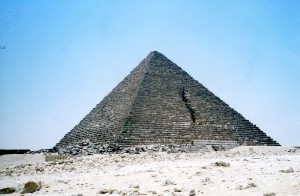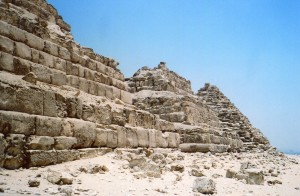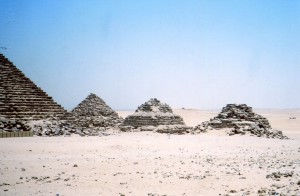Menkaure’s pyramid at Giza may not look as impressive at first glance. It’s 204 foot height is less than half of Khufu’s (the Great Pyramid), and Khafre’s.
But Menkaure’s pyramid has unique facets that make it well worth exploring too.
1. Menkaure’s pyramid had a mortuary temple at its foot and a valley temple near the Nile, though they’re not as well-preserved as Khafre’s temples. Both pharaohs’ temples have similar designs. Menkaure’s temples are larger relative to the pyramid. The trend of emphasizing temples more and pyramids less, which began with Khafre’s complex, thus gained momentum.
2. Three queens’ pyramids stand to the south of Menkaure’s.
3. Menkaure built his pyramid at the southwestern edge of the Giza Plateau–the opposite corner from the one that the Great Pyramid stands on. As you can see in the above photo of the queens’ pyramids at the foot of Menkaure’s, there’s nothing but desert after these buildings. The pyramid thus makes the Giza site complete. Grandfather (Khufu), father (Khafre) and son stand together and preserve Ancient Egypt’s well-being into eternity.
4. Menkaure’s complex was unfinished when he died, and his son and successor, Shepseskaf, finished it.
5. Menkaure’s pyramid is aligned with Khafre’s and Khufu’s–all three were placed along a line that pointed to the center of the sun’s cult at Heliopolis.
6. Menkaure’s pyramid’s smaller size may be due to its location at the edge of the Giza Plateau–its builders were running out of room. But pyramids were extremely costly, and Khufu and Khafre had reputations for being tyrants by the time the 5th century BCE Greek historian Herodotus studied Ancient Egypt. Egyptians by then saw Menkaure as easy-going. Temples were also becoming more prominent. Maybe all three–limited space, limited resources, and political necessity–converged.
So, Menkaure’s pyramid represents both perfection and transition. On one hand, it completes the whole site at Giza. All stand together and form a model of order that still captivates people all over the world. But Egyptians were developing new ways to embody their ideals of eternal well-being, and they were starting to emphasize them more. Khafre’s reign had already produced more sculptures than others had–art was becoming more humanized. In the next post, we’ll see that Egyptian literature was also advancing, and it generated movements as monumental as the pyramids.




{ 1 comment }
Dear Mr Brian!
I was reading your article about Menkaure. I want to give You an other article about him!
“Mencaure hidden calendar” on YouTube too.
Best wishes, András Goczey
Comments on this entry are closed.